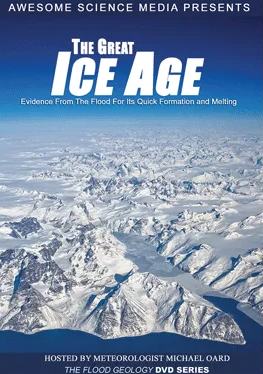The importance of the mineral calcium phosphate to living organisms can hardly be overstated. It is used by many organisms, including humans, to build their bones and skeletons. This is especially true for fish, crustaceans, and some brachiopods. Besides that, and even more importantly, phosphate ions are required for major building blocks of life, such as DNA and RNA. It is also required for the production of adenosine triphosphate (ATP)—the molecular fuel of living cells (Brady, Tostevin and Tosca 2022).
Evolutionists struggle to explain how life could have arisen from non-life—a concept known as “abiogenesis” or “spontaneous generation.” One of the problems is the importance of phosphate ions for biological molecules and the prohibitively low concentrations of phosphates in nature for those molecules to form spontaneously. There just isn’t enough phosphate. Phosphate minerals tend to be insoluble under most conditions, so only trace amounts exist as dissolved minerals in seawater. In fact, on average, seawater contains only about 0.071 parts per million of phosphorous (Simandl, Paradis and Fajber 2012).
Phosphate rocks, called phosphorites, are a type of sedimentary rock. Most sedimentary rocks are made up of small particles of previously existing rock that has been broken up by weathering and erosion, carried to a new location, and redeposited. Secular scientists believe the calcium phosphate in phosphorites came from the mineral apatite (which is also the mineral in our bones and teeth) in igneous rocks like granite. The granite was broken up and eroded, and the phosphate minerals were dissolved in water and carried by rivers to the ocean. However, this is not how we observe phosphorites forming today.
Phosphates seem to be fixed and concentrated by biological processes. In other words, phosphorites require life as much as life requires phosphate ions. Off the west coasts of Africa and South America, upwelling of nutrient-rich cold water causes algal blooms. The algae bring those nutrients, including phosphates, into the food web. Dead algae, fecal pellets, and other organic matter accumulate on the continental shelves near the coastal upwelling. Decomposition depletes oxygen, so anaerobic bacteria (that don’t need much oxygen) break down the organic matter and help precipitate the phosphate minerals (Simandl, Paradis and Fajber 2012).
76% of phosphorites are believed to have formed through these biological processes. Another 23% is derived from igneous rock—rock that was once molten and then weathered. The remaining 1% is said to be deposited in guano (bird droppings). The size of many of the phosphorite deposits on the Pacific Islands, such as on the island of Nauru, makes it unlikely that much of the 1% was produced by bird droppings. They were more likely formed in a shallow marine environment, similar to many other marine deposits (the 76%) (Walker 2015). So is this the only way to explain where the phosphorites came from?
One creationist explanation says that the geological activity of the Flood would have increased the rate of weathering and erosion of the originally created bedrock and resulted in disturbances in temperatures, sea levels, water currents, and chemical composition in the oceans. As the Flood waters receded off the continents, relatively high concentrations of phosphates, water circulation, and differences in solubility would have created conditions for the minerals to precipitate out (Walker 2015).
Another explanation starts from the beginning of the Flood when “the fountains of the great deep burst forth,” (Genesis 7:11) so that there was a release of immense quantities of water from within Earth’s crust, even from as far down as water dissolved in the mantle. This massive geological event would have also included volcanic eruptions. When volcanoes erupt, they tend to release various gases that are dissolved in the molten rock. As magma rises and is extruded onto the surface as lava, the pressure decreases, and the dissolved gases bubble out. Volcanic gases are mostly made up of water vapour and carbon dioxide. Other gases include sulphur dioxide, hydrogen chloride, hydrogen sulphide, and hydrogen fluoride. These can dissolve in water, forming acid (Dickens and Snelling, 2015).
The torrential rain of the Flood resulted in huge numbers of animals and people being drowned and swept into the ocean. Some creationist geologists think the water may have been very acidic near the fountains, dissolving vertebrate bones and invertebrate shells. This would have greatly increased the amount of dissolved phosphate in the ocean, which may have caused huge algal blooms during the Flood year. Further from the fountains, the lower temperature and higher pH of the water would have been closer to normal, allowing phosphates to precipitate out (Dickens and Snelling 2015).
Phosphate fossils called Orsten have been found in even the deepest Flood sediments. Orsten-type fossils are tiny—less than 2mm. They are formed when calcium phosphate incrusts the remains of an organism encased in sediments, usually bitumen-rich limestone, forming a kind of cast of the organism. This can preserve some of microscopic organisms’ tiniest, most delicate details. Usually, the phosphate cast is hollow where the soft tissues have decayed away. Secular scientists believe that phosphatized fossils formed near the decaying soft tissues of bony fish or in the living chambers of cephalopods (Maas, et al. 2006), but there are problems with this.
Experiments have shown that phosphatization had to happen quickly before the organism decayed. It only takes one or two weeks for the filtering limbs of water fleas to decompose completely, so preservation has to happen within a few hours to a few days after death. Anaerobic bacteria appear to play a major role. Large amounts of decaying organic matter are required to reduce the amount of oxygen available and increase the growth of anaerobic bacteria, but the sediment layers containing Orsten-type fossils do not contain evidence of large communities of organisms. Another puzzling thing about these fossils is that they are found in rocks lacking any phosphate minerals except for the fossils themselves. This is interpreted as the result of “winnowing” and re-sedimentation. In other words, the fossils and other sediment particles are believed to have been picked up and carried in the water current away from the phosphate source, and then heavier particles fell to the bottom first as the current slowed, resulting in layers with lots of Orsten fossils and phosphate nodules (Maas, et al. 2006).
However, some researchers have done other experiments to try to understand how anaerobic bacteria work to deposit phosphates. One of those experiments resulted in blocks of muscle tissue, individual muscle fibres, and eggs of shrimp and prawns being replaced by calcium phosphate sourced entirely from the crustaceans’ carcasses. No other phosphate source was required. The mineralization process only took two to four weeks. Despite the speed at which this process occurred in the laboratory, secular researchers still believe it takes hundreds of millions of years in nature (Palmer 1994).
You would think evolutionists might question the “millions of years” paradigm in light of the evidence that fossils don’t need that much time to form. Not only can phosphorites form quickly, but the large deposits mined in the present show evidence of catastrophic Flood processes and the decomposition of massive amounts of organic matter.
Works Cited
Brady, Matthew P. et al. 2022. “Marine phosphate availability and the chemical origins of life on Earth.” Nature Communications 13 (1): 1-9. Accessed July 24, 2023. doi:doi.org/10.1038/s41467-022-32815-x.
Dickens, Harry, and Andrew Snelling. 2015. “Terrestrial Vertebrates Dissolved Near Flood Fountains.” Answers Research Journal 8: 437-447. Accessed August 8, 2023. https://answersresearchjournal.org/terrestrial-vertebrates-flood-fountains/#.
Maas, Andreas, et al. 2006. “The ‘Orsten’ — More than a Cambrian Konservat-Lagerstatte yielding exceptional preservation.” Palaeoworld 15 (3-4): 266-282. Accessed February 9, 2023. doi:https://doi.org/10.1016/j.palwor.2006.10.005.
Palmer, Douglas. 1994. “Science: How busy bacteria turn flesh into stone.” New Scientist, March 19. Accessed July 20, 2023. https://www.newscientist.com/article/mg14119172-600-science-how-busy-bacteria-turn-flesh-into-stone/.
Simandl, G.J., S. Paradis, and R. Fajber. 2012. “Sedimentary Phosphate Deposits Mineral Deposit Profile F07.” Geological Fieldwork 2011, Paper 2012-1. BC: British Columbia Geological Survey. 217-222. Accessed September 13, 2023. https://cmscontent.nrs.gov.bc.ca/geoscience/PublicationCatalogue/Paper/BCGS_P2012-01-16_Simandl.pdf.
Walker, Tas. 2015. The phosphate deposits on Nauru, western Pacific Ocean. September 12. Accessed July 21, 2023. https://creation.com/nauru-phosphate-deposits#.
Andrea Reitan
July 2025
Subscribe to Dialogue






